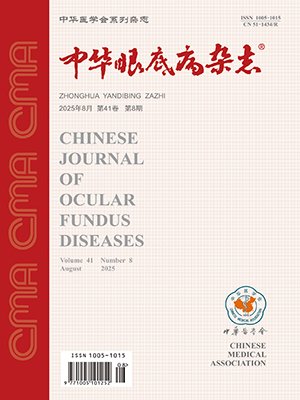| 1. |
Bressler NM. Age-related macular degeneration is the leading cause of blindness[J]. JAMA, 2004, 291(15): 1900-1901. DOI: 10.1001/jama.291.15.1900.
|
| 2. |
Wong TY, Ferreira A, Hughes R, et al. Epidemiology and disease burden of pathologic myopia and myopic choroidal neovascularization: an evidence-based systematic review[J]. Am J Ophthalmol, 2014, 157(1): 9-25. DOI: 10.1016/j.ajo.2013.08.010.
|
| 3. |
Xu D, Dãvila JP, Rahimi M, et al. Long-term progression of type 1 neovascularization in age-related macular degeneration using optical coherence tomography angiography[J]. Am J Ophthalmol, 2018, 187: 10-20. DOI: 10.1016/j.ajo.2017.12.005.
|
| 4. |
Cheng Y, Li Y, Huang X, Qu Y. Application of optical coherence tomography angiography to assess anti-vascular endothelial growth factor therapy in myopic choroidal neovascularization[J/OL]. Retinal, 2017, 2017: E1[2017-12-18]. https://insights.ovid.com/crossref?an=00006982-900000000-96633. DOI: 10.1097/IAE.0000000000002005. [published online ahead of print].
|
| 5. |
Amoaku WM, Chakravarthy U, Gale R, et al. Defining response to anti-VEGF therapies in neovascular AMD[J]. Eye, 2015, 29(6): 721-727. DOI: 10.1038/eye.2015.48.
|
| 6. |
Miere A, Butori P, Cohen SY, et al. Vascular remodeling of choroidal neovascularization after anti-vascular endothelial growth factor therapy visualized on optical coherence tomography angiography[J/OL]. Retina, 2017, 2017: E1[2017-11-23]. https://insights.ovid.com/crossref?an=00006982-900000000-96687. DOI: 10.1097/IAE.0000000000001964. [published online ahead of print].
|
| 7. |
Iafe NA, Phasukkijwatana N, Sarraf D. Optical coherence tomography angiography of type 1 neovascularization in age-related macular degeneration[J]. Dev Ophthalmol, 2016, 56: 45-51. DOI: 10.1159/000442776.
|
| 8. |
Mastropasqua L, Toto L, Borrelli E, et al. Optical coherence tomography angiography assessment of vascular effects occurring after aflibercept intravitreal injections in treatment-naive patients with wet age-related macular degeneration[J]. Retina, 2017, 37(2): 247-256. DOI: 10.1097/IAE.0000000000001145.
|
| 9. |
孙姣, 王艳玲, 王佳琳. 光相干断层扫描血管成像在近视中的应用研究进展[J]. 中华眼底病杂志, 2018, 34(1): 83-86. DOI: 10.3760/cma.j.issn.1005-1015.2018.01.025.Sun J, Wang YL, Wang JL. Advances of optical coherence tomography angiography in myopia[J]. Chin J Ocul Fundus Dis, 2018, 34(1): 83-86. DOI: 10.3760/cma.j.issn.1005-1015.2018.01.025.
|
| 10. |
黎晓新, 石璇. 认识光相干断层扫描血管成像技术特色, 提升光相干断层扫描血管成像技术临床应用水平[J]. 中华眼底病杂志, 2017, 33(1): 3-6. DOI: 10.3760/cma.j.issn.1005-1015.2017.01.002.Li XX, Shi X. Clinical applications of optical coherence tomography angiography[J]. Chin J Ocul Fundus Dis, 2017, 33(1): 3-6. DOI: 10.3760/cma.j.issn.1005-1015.2017.01.002.
|
| 11. |
Toto L, Borrelli E, Di A L, et al. Retinal vascular plexuses' changes in dry age-related macular degeneration, evaluated by means of optical coherence tomography angiography[J]. Retina, 2016, 36(8): 1566-1572. DOI: 10.1097/IAE.0000000000000962.
|
| 12. |
Mo J, Duan A, Chan S, et al. Vascular flow density in pathological myopia: an optical coherence tomography angiography study[J/OL]. BMJ Open, 2017, 7(2): e013571[2017-02-03]. DOI: 10.1136/bmjopen-2016-013571.
|




